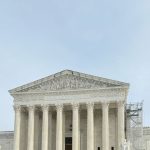
The Supreme Court on Tuesday paused an order by a judge in San Francisco that would require the federal government to reinstate more than 16,000 workers who were fired by six agencies earlier this year. A group of nonprofits challenging the layoffs argued that the terminations by the Office of Personnel Management violated several different parts of the federal law governing administrative agencies. But by an apparent vote of 7-2, the justices nonetheless put the order by Senior U.S. District Judge William Alsup on hold while the challenge to the firings continues, explaining that the nonprofits do not have a legal right, known as standing, to challenge the terminations.
In a brief unsigned order, the court explained that it was not weighing in on the claims by other plaintiffs in the lawsuit – specifically, unions representing government employees, whose claims Alsup did not address because he concluded that he likely did not have the power to hear them. The court also did not weigh in on the propriety of the firings more generally.
Justice Sonia Sotomayor indicated that she would have denied the Trump administration’s request to pause Alsup’s order.
Justice Ketanji Brown Jackson also would have turned down the Trump administration’s plea, because she would not have reached the question of the nonprofits’ standing to sue at this stage of the case.
The layoffs of tens of thousands of probationary employees – that is, employees who have been newly hired for a position, usually within the past year – in February came as part of a broader effort by the Trump administration to reduce the size of the federal workforce.
A group of nonprofits, arguing that layoffs could lead to fewer government services, which could in turn harm their members, went to federal court in San Francisco, seeking to have the probationary employees returned to their jobs.
Alsup concluded that although federal agencies can fire their own employees, the “Office of Personnel Management has no authority to hire and fire employees in another agency.” On March 13, he issued a preliminary injunction that directed OPM and six federal agencies – the Departments of Veterans Affairs, Agriculture, Defense, Energy, Interior, and the Treasury – to immediately bring back the probationary employees who had been fired.
A federal appeals court rejected the government’s request to put Alsup’s order on hold while its appeal – which the court agreed to fast-track – moved forward.
The Trump administration came to the Supreme Court on March 25, asking the justices to temporarily pause Alsup’s order. Sarah Harris, then the acting U.S. solicitor general, contended (among other things) that the nonprofits do not have a legal right to sue, known as standing, to challenge the layoffs. Alsup’s ruling, she argued, also lets “third parties hijack the employment relationship between the federal government and its workforce.”
The nonprofits countered that they have standing to sue because the layoffs will affect their members – for example, the firings of workers at the Department of Veterans Affairs “has already had and will imminently continue to have serious negative consequences” for the members of a veterans’ nonprofit who rely on federal services. And Alsup’s order, they wrote, simply “restored the status quo that existed prior to OPM’s illegal conduct.”
The two-paragraph order on Tuesday explained that Alsup’s order “was based solely on the allegations of the nine” nonprofits challenging the layoffs. But those allegations, the majority continued, “are presently insufficient” to give the nonprofits a legal right to sue. “This order does not address the claims of the other plaintiffs,” the majority noted, “which did not form the basis of” Alsup’s order.
Sotomayor noted only that she would have denied the Trump administration’s request, without explanation.
Jackson explained that, in an emergency appeal like this one, “where the issue is pending in the lower courts and the applicants have not demonstrated urgency in the form of interim irreparable harm,” she would not have ruled on the standing question at all.
Although the court put Alsup’s order on hold, a different federal judge in Maryland also has issued an order, which remains in effect for now, that requires the reinstatement of probationary employees at 20 federal agencies who live and work in the 19 states (along with the District of Columbia) that brought the case.
Tuesday’s order was the second in less than 24 hours putting a federal district judge’s order on hold and allowing – at least for now – the Trump administration to move forward with implementing its policies. On Monday evening, a closely divided court lifted a pair of orders by U.S. District Judge James Boasberg that had prohibited the government from removing noncitizens designated as members of a Venezuelan gang under a March 15 executive order issued by President Donald Trump. The majority in that case agreed with their dissenting colleagues – Sotomayor and Jackson, along with Justices Elena Kagan and Amy Coney Barrett – that noncitizens are entitled to notice and an opportunity to challenge their removal.
This article was originally published at Howe on the Court.
The post Justices pause order to reinstate fired federal employees appeared first on SCOTUSblog.



